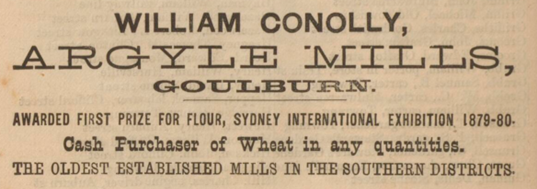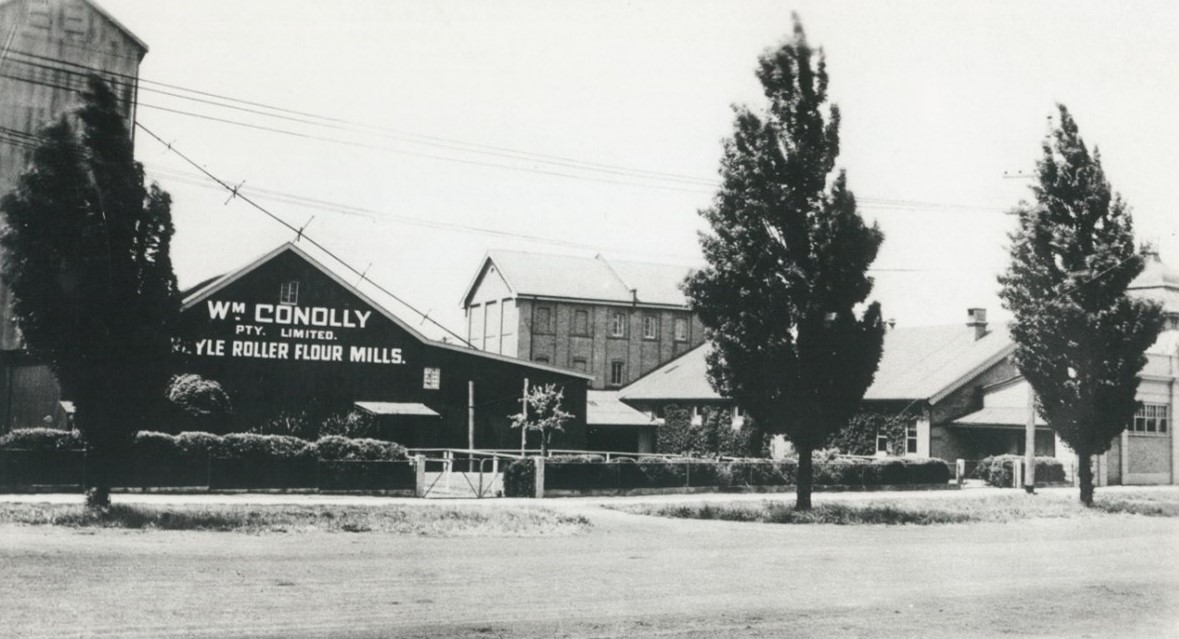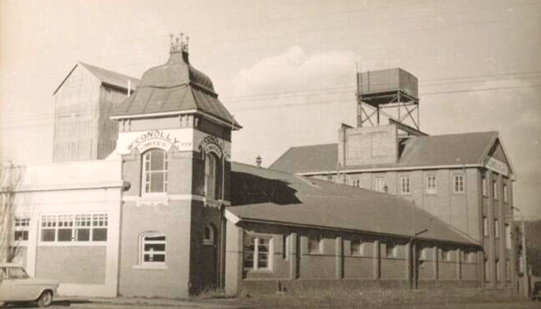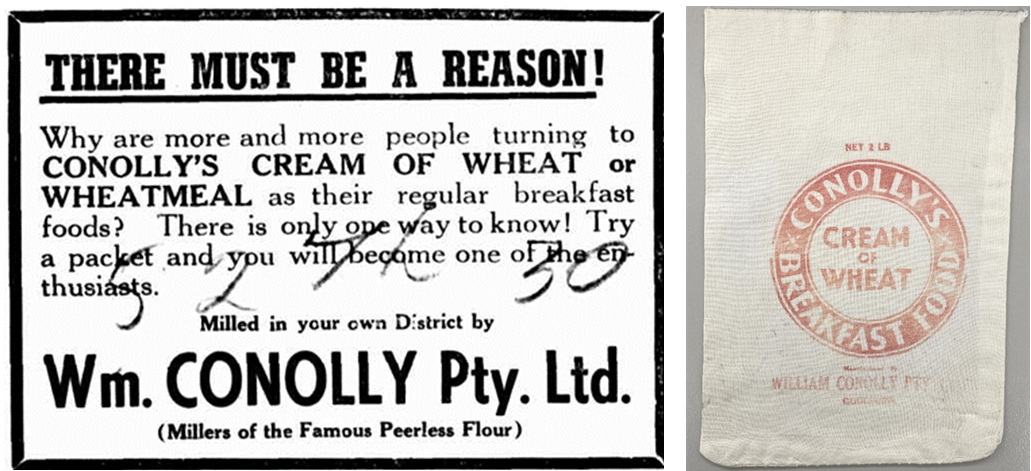Connolly's Mill
One of the wonderful things about Goulburn is its abundance of heritage buildings and the history that they share. Buildings may be passed down through families for generations, or they may be bought and sold with various new reincarnations at each sale. One such building that has been revamped and repurposed multiple times is the building on the corner of Sloane and Goldsmith Streets. Most recently, it would be recognised as the old Furniture Warehouse building, however those in the know will speak of its history as Conolly’s Mill or the original Swimming Baths of Goulburn.
Baths necessary for the health of citizens.
Take a step back in time to the late 1800s when discussion was raised about the importance of providing a public bathing area for the community. In 1881 Alderman Wombey stated that “every alderman knew that baths were necessary for the health of citizens” (Goulburn Evening Penny Post, Thursday 27th October, 1881, pg. 2). Mr. William Martin, the Chairman of the Bath Committee also highlighted the importance of the baths with the Report of the Bath Committee on January 1881.

Report of the Bath Committee. (January 15, 1881). Goulburn Evening Penny Post (NSW : 1881 - 1940), p. 2. http://nla.gov.au/nla.news-article102820528
Discussion continued for many years about the value of the public baths, but the idea never progressed for a multitude of reasons. However, well-known local businessman, Charles Rogers, made his opinion very clear in 1886 that one of the main hurdles for establishing a public baths, the availability of water, had been removed.

Turkish Baths for Goulburn. (June 8, 1886). Goulburn Evening Penny Post (NSW : 1881 - 1940), p. 2. http://nla.gov.au/nla.news-article98461125
After the decision was made to build a public baths, many sites were proposed but none were settled upon. That was until 1889, when an area of 3 roods and 3 perches at the corner of Sloane and Goldsmith Streets was dedicated for the site of the public baths in the Borough Council of Goulburn.

Goulburn City Council Minutes 1901-1906.
The council called for competitive designs to be sent in for the creation of the public baths. Even though the Goulburn Evening Penny Post (Tuesday 19th May 1891 pg. 2) reported that architects Messrs. McKinnon and Weitzel’s design had been accepted, it would be prominent architect E.C Manfred’s design that would be the eventual winner.

Newspaper clipping from the Swimming Pools Vertical File. Original Public Baths plans available at History Goulburn.
The baths were to be built to a strict budget of no more than £2000 and the tender of Messrs. Wilke Bros was accepted for the construction work.

Goulburn City Council Minutes 1901-1906.
The design included a 12ft square tower, which provided access to the baths. Modesty could be maintained with the 52 dressing rooms and shower stalls, and modern conveniences like a shop, lounge and viewing gallery were also included. The size of the bath was 80ft x 25ft, with a depth ranging from 2 feet 6 inches at its shallow end to 7 feet at its deepest. There was concern that this depth would not be sufficient for diving and that patrons could hit their heads, however the Mayor stated upon opening the baths that he thought “a person would have to be very drunk before he would do such a thing” (Goulburn Evening Penny Post, Saturday 19th November 1892, pg. 4).
Excitement and anticipation was high for the grand opening of the baths, which finally occurred on the 18th November 1892. The Mayor of the time, Mr. E. Howard, opened the grand building and commented that “he was sure that a great many of those who had been waiting a number of years for a convenient place near their homes for bathing purposes, and where they would not be afraid of the interference of the gentlemen in blue, would hail the baths with delight” (Goulburn Evening Penny Post, Saturday 19th November 1892, pg. 4).

Original swimming baths plaque – PF. 21 no. 3912.
Noting that the baths were opened in a very different time, a time before women could vote and when modesty and privacy was of the utmost importance, it was no surprise to find that the opening hours for the baths included a limited time for when ladies were permitted to use the facilities.

Advertising (February 10, 1900). Goulburn Evening Penny Post (NSW : 1881 - 1940), p. 5. http://nla.gov.au/nla.news-article98701003
According to articles in the Goulburn Evening Penny Post, the move to mixed bathing in Goulburn finally occurred in 1930, for Sunday afternoons, and then at all hours in 1934 (Goulburn Evening Penny Post, 26th January 1934, pg. 2).
The baths, although providing a wonderful service, ran at a loss for many years and in 1906 the council decided to sell the site at a price of £1000. This paved the way for the council to build a new Municipal Baths site at Victoria Park and for a new chapter in the history of 285 Sloane Street.

Goulburn City Council Minutes 1901-1906.
285 Sloane Street: the next chapter.
The site of the public baths was sold to Messrs. William Conolly Limited, who converted it into a profitable and forward-thinking flour mill opening in 1908.
William Conolly, an Irishman who migrated to Sydney in 1853, had no intention of owning a flour mill upon his arrival to Australia. However, after discussions with an associate, Mr Oakes, he deemed it a good investment and eventually purchased the Argyle Steam Flour Mill located on the corner of Sloane and Clinton Streets from James Sinclair in 1852.

Left: William Conolly’s Argyle Steam Flour Mill, PF-21 no. 3926. Right: Argyle Flour Mill c.1900, photo from CD-01 no. 7346.
The Argyle Steam Flour Mill was very successful, won many awards, and became widely known in the area for its quality.

The Goulburn and District directory for 1882-3, pg. 36. http://nla.gov.au/nla.obj-404051549
On the death of William Conolly in 1887, the responsibility of the business passed to his son Russell Conolly. It was under his management that the company became a family propriety company in 1903, honouring his father’s name with the new name of Wm. Conolly Pty Ltd.
Due to its proximity to the railway line, the company purchased the site of the old public baths as a more convenient site for the flour mill, moving there in 1908.

William Conolly Pty Ltd Argyle Roller Flour Mills, PF-33 no. 5824.
The flour mill was at the forefront of technology and was always looking for ways to upgrade and improve its efficiency. This led to the building of a large silo in 1925 which became the talk of the town.

HUGE WHEAT SILO (February 3, 1925). Goulburn Evening Penny Post (NSW : 1881 - 1940), p. 2 (EVENING). http://nla.gov.au/nla.news-article102758418
At just over 25m high, the silo was capable of holding 60,000 bushels of wheat which was filled and emptied on a regular basis. The towering silo can be seen standing behind the main building in the photo below.

Architectural survey of Goulburn. http://nla.gov.au/nla.obj-430937650
Although the silo is long gone, this blueprint created by Sydney engineers Thomas Robinson and Son shows the detail of the internal structure and mechanisms of the 15-bin silo.

Grain Silo – William Conolly Limited Blueprint, Library Map Cabinet 1 no. 0110.
In 1946 the business had another notable achievement, that being the installation of an automatic sprinkler system. The mill was the first business in Goulburn to see the necessity of this technology and have it installed onsite. Importantly, if a fire broke out in the silos, water would be deflected from those areas to avoid the wheat swelling and potentially bursting the silo walls.

SPRINKLER SYSTEM (June 25, 1946). Goulburn Evening Post (NSW : 1940 - 1954), p. 2 (Daily and Evening). http://nla.gov.au/nla.news-article103294458
Conolly’s Mill continued producing and exporting flour and wheat products for many years, supplying many households with pantry staples such as cream of wheat and wheatmeal to fill their stomachs.

Left: Advertising (July 23, 1942). Goulburn Evening Post (NSW : 1940 - 1954), p. 4 (Daily. http://nla.gov.au/nla.news-article99783859. Right: Cream of Wheat Bag, Conolly’s Mill Vertical File.
Connolly's Mill closure.
Connolly’s Mill closed in in the 1970s, which brought an end to that significant era. After the closure of Conolly’s Mill, the building at 285 Sloane Street would be utilised by many businesses, including Sainsbury Constructions Pty Ltd. In 1983 it was repurposed as the Goulburn Leisure Centre, which included a tenpin bowling alley and skating rink (Heritage Study Review, 2018).

Left: Sainsbury Constructions Pty Ltd, PF-2 no.378. Right: Goulburn Leisure Centre, Photographic Slide PF-73 no. 15156.
It is fun to note that it was foreseen that the site would be used as a skating rink prior to the original swimming baths even being built. In 1888 Alderman Ball put forward that a Public Baths Committee “take into consideration the advisability of constructing the baths so that the same building can be used for a skating rink in winter” (Goulburn Evening Penny Post, May 26, 1888, p. 4).
Although Alderman Ball probably expected the site to be utilised as an ice-skating rink in Goulburn’s cold winters, it is nice to think that in some way his vision for the site was achieved.
The final reincarnation of the building was its conversion to the Goulburn Furniture Warehouse. The original Public Baths sat idly below floorboards, and in a Goulburn Post article (25-26th November, 1996, pg. 13, Swimming Vertical File), Dan Russell, who was in the process of renovating the site after moving his furniture stock elsewhere stated “I think this area is just the right size for a heated pool and part of Goulburn’s history that should be preserved”. Unfortunately, no parties have been interested in restoring the old baths, and so they remain hidden in our history.

Furniture Warehouse, PF-27 no. 5213.
The site was added to the New South Wales State Heritage Register on 2 April 1999, and in February 2024 it was sold to a Sydney company which will bring about yet another new chapter for this historic site.
From the original public baths, to a highly regarded flour mill, an entertainment centre, and retail businesses, 285 Sloane Steet has provided many wonderful services to the citizens of Goulburn. What the future holds for this building, only time will tell.
Further reading at Goulburn Mulwaree Library:
Goulburn City Council Meeting Minutes 1901-1906.
Connolly Family Vertical File.
Connolly's Mill Vertical File.
Goulburn Heritage Study Review January 2018.
The History of Goulburn, NSW, by Ransome T. Wyatt.
Various photos from the Local Studies photo collection.
